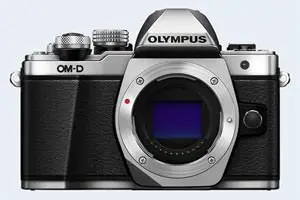Canon G3 X vs Olympus E-M10 II
The Canon PowerShot G3 X and the Olympus OM-D E-M10 Mark II are two digital cameras that were announced, respectively, in June 2015 and August 2015. The G3X is a fixed lens compact, while the E-M10 II is a mirrorless interchangeable lens camera. The cameras are based on an one-inch (G3X) and a Four Thirds (E-M10 II) sensor. The Canon has a resolution of 20 megapixels, whereas the Olympus provides 15.9 MP.
Below is an overview of the main specs of the two cameras as a starting point for the comparison.

Check G3X offers at
ebay.com

Check E-M10 II offers at
ebay.com
Going beyond this snapshot of core features and characteristics, what are the differences between the Canon PowerShot G3 X and the Olympus OM-D E-M10 Mark II? Which one should you buy? Read on to find out how these two cameras compare with respect to their body size, their imaging sensors, their shooting features, their input-output connections, and their reception by expert reviewers.
Body comparison
The side-by-side display below illustrates the physical size and weight of the Canon G3 X and the Olympus E-M10 II. The two cameras are presented according to their relative size. Three successive views from the front, the top, and the rear are shown. All width, height and depth dimensions are rounded to the nearest millimeter.
The E-M10 II can be obtained in three different colors (black, silver, brown), while the G3X is only available in black.
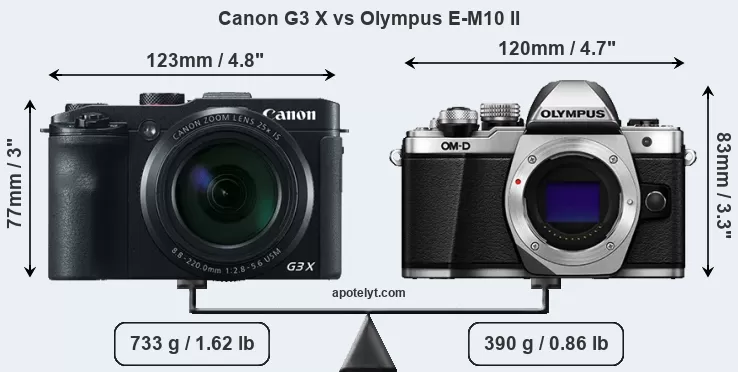
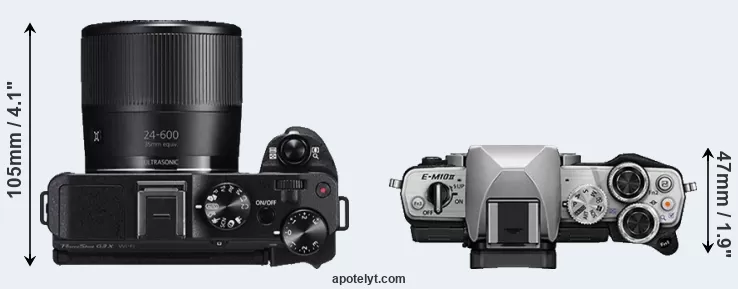
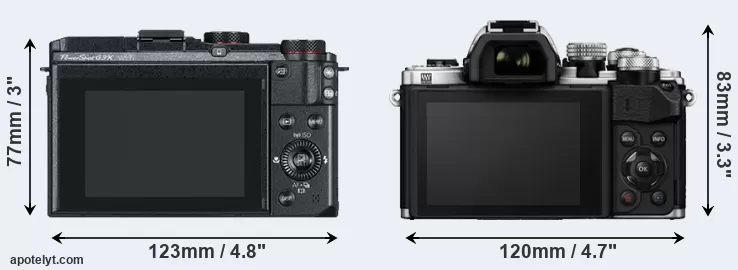
If the front view area (width x height) of the cameras is taken as an aggregate measure of their size, the Olympus E-M10 II is notably larger (5 percent) than the Canon G3 X. It is worth mentioning in this context that the G3X is splash and dust resistant, while the E-M10 II does not feature any corresponding weather-sealing.
The above size and weight comparisons are to some extent incomplete and possibly misleading, as the G3X has a lens built in, whereas the E-M10 II is an interchangeable lens camera that requires a separate lens. Attaching the latter will add extra weight and bulk to the setup. You can compare the optics available for the E-M10 II and their specifications in the Micro Four Thirds Lens Catalog.
Concerning battery life, the G3X gets 300 shots out of its Canon NB-10L battery, while the E-M10 II can take 320 images on a single charge of its Olympus BLS-50 power pack.
The adjacent table lists the principal physical characteristics of the two cameras alongside a wider set of alternatives. In case you want to display and compare another camera duo, you can use the CAM-parator app to select your camera combination among a large number of options.

| Camera Model |
Camera Width |
Camera Height |
Camera Depth |
Camera Weight |
Battery Life |
Weather Sealing |
Camera Launch |
Launch Price |
Street Price |
||
|---|---|---|---|---|---|---|---|---|---|---|---|
| 1. | Canon G3 X | 123 mm | 77 mm | 105 mm | 733 g | 300 | Y | Jun 2015 | EUR 899 | ebay.com | |
| 2. | Olympus E-M10 II | 120 mm | 83 mm | 47 mm | 390 g | 320 | n | Aug 2015 | EUR 599 | ebay.com | |
| 3. | Canon 7D II | 149 mm | 112 mm | 78 mm | 910 g | 670 | Y | Sep 2014 | EUR 1 699 | ebay.com | |
| 4. | Canon 70D | 139 mm | 104 mm | 79 mm | 755 g | 920 | Y | Jul 2013 | EUR 1 099 | ebay.com | |
| 5. | Canon 80D | 139 mm | 105 mm | 79 mm | 730 g | 960 | Y | Feb 2016 | EUR 1 285 | ebay.com | |
| 6. | Canon G9 X | 98 mm | 58 mm | 31 mm | 209 g | 220 | n | Oct 2015 | EUR 499 | ebay.com | |
| 7. | Nikon D7200 | 136 mm | 107 mm | 76 mm | 765 g | 1110 | Y | Mar 2015 | EUR 1 179 | ebay.com | |
| 8. | Olympus E-M5 II | 124 mm | 85 mm | 45 mm | 469 g | 310 | Y | Feb 2015 | EUR 1 099 | ebay.com | |
| 9. | Olympus E-M10 | 119 mm | 82 mm | 46 mm | 396 g | 320 | n | Jan 2014 | EUR 599 | ebay.com | |
| 10. | Olympus E-M10 III | 122 mm | 84 mm | 50 mm | 410 g | 330 | n | Aug 2017 | EUR 649 | ebay.com | |
| 11. | Olympus E-PL7 | 115 mm | 67 mm | 38 mm | 357 g | 350 | n | Aug 2014 | EUR 599 | ebay.com | |
| 12. | Panasonic FZ1000 | 137 mm | 99 mm | 131 mm | 831 g | 360 | n | Jun 2014 | EUR 899 | ebay.com | |
| 13. | Panasonic GX80 | 122 mm | 71 mm | 44 mm | 426 g | 290 | n | Apr 2016 | EUR 799 | amazon.com | |
| 14. | Sony RX10 II | 129 mm | 88 mm | 102 mm | 813 g | 400 | Y | Jun 2015 | EUR 1 599 | ebay.com | |
| 15. | Sony RX10 III | 133 mm | 94 mm | 127 mm | 1051 g | 420 | Y | Mar 2016 | EUR 1 599 | ebay.com | |
| 16. | Sony RX100 IV | 102 mm | 58 mm | 41 mm | 298 g | 280 | n | Jun 2015 | EUR 1 149 | ebay.com | |
| 17. | Sony RX100 V | 102 mm | 58 mm | 41 mm | 299 g | 220 | n | Oct 2016 | EUR 1 199 | ebay.com | |
| Note: Measurements and pricing do not include easily detachable parts, such as add-on or interchangeable lenses or optional viewfinders. | |||||||||||
The price is, of course, an important factor in any camera decision. The listed launch prices provide an indication of the market segment that the manufacturer of the cameras have been targeting. Usually, retail prices stay at first close to the launch price, but after several months, discounts become available. Later in the product cycle and, in particular, when the replacement model is about to appear, further discounting and stock clearance sales often push the camera price considerably down.
Sensor comparison
The size of the sensor inside a digital camera is one of the key determinants of image quality. A large sensor will tend to have larger individual pixels that provide better low-light sensitivity, wider dynamic range, and richer color-depth than smaller pixel-units in a sensor of the same technological generation. Further, a large sensor camera will give the photographer additional creative options when using shallow depth-of-field to isolate a subject from its background. On the downside, larger sensors tend to be more expensive and lead to bigger and heavier cameras and lenses.
Of the two cameras under consideration, the Canon G3 X features an one-inch sensor and the Olympus E-M10 II a Four Thirds sensor. The sensor area in the E-M10 II is 94 percent bigger. As a result of these sensor size differences, the cameras have a format factor of, respectively, 2.7 and 2.0. The sensor in the G3X has a native 3:2 aspect ratio, while the one in the E-M10 II offers a 4:3 aspect.
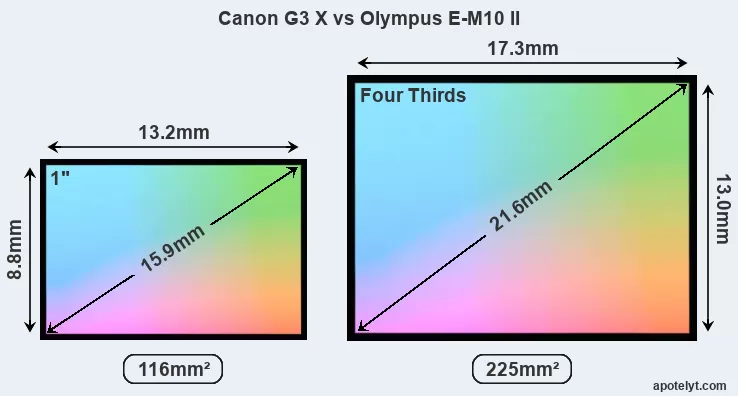
Despite having a smaller sensor, the Canon G3 X offers a higher resolution of 20 megapixels, compared with 15.9 MP of the Olympus E-M10 II. This megapixels advantage comes at the cost of a higher pixel density and a smaller size of the individual pixel (with a pixel pitch of 2.41μm versus 3.76μm for the E-M10 II). It is noteworthy in this context that the two cameras were released in close succession, so that their sensors are from the same technological generation. Coming back to sensor resolution, it should be mentioned that the E-M10 II has no anti-alias filter installed, so that it can capture all the detail its sensor resolves.
The resolution advantage of the Canon G3 X implies greater flexibility for cropping images or the possibility to print larger pictures. The maximum print size of the G3X for good quality output (200 dots per inch) amounts to 27.4 x 18.2 inches or 69.5 x 46.3 cm, for very good quality (250 dpi) 21.9 x 14.6 inches or 55.6 x 37.1 cm, and for excellent quality (300 dpi) 18.2 x 12.2 inches or 46.3 x 30.9 cm. The corresponding values for the Olympus E-M10 II are 23 x 17.3 inches or 58.5 x 43.9 cm for good quality, 18.4 x 13.8 inches or 46.8 x 35.1 cm for very good quality, and 15.4 x 11.5 inches or 39 x 29.3 cm for excellent quality prints.
The Canon PowerShot G3 X has a native sensitivity range from ISO 125 to ISO 12800, which can be extended to ISO 125-25600. The corresponding ISO settings for the Olympus OM-D E-M10 Mark II are ISO 200 to ISO 25600, with the possibility to increase the ISO range to 100-25600.
In terms of underlying technology, the G3X is build around a BSI-CMOS sensor, while the E-M10 II uses a CMOS imager. Both cameras use a Bayer filter for capturing RGB colors on a square grid of photosensors. This arrangement is found in most digital cameras.
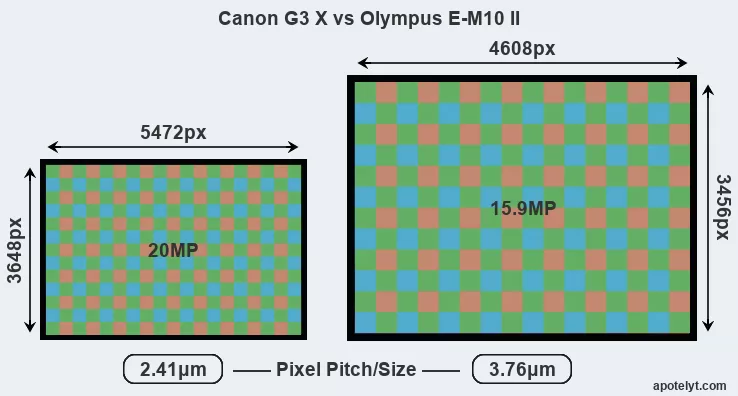
For many cameras, data on sensor performance has been reported by DXO Mark. This service is based on lab testing and assigns an overall score to each camera sensor, as well as ratings for dynamic range ("DXO Landscape"), color depth ("DXO Portrait"), and low-light sensitivity ("DXO Sports"). Of the two cameras under consideration, the E-M10 II has a markedly higher DXO score than the G3X (overall score 10 points higher), which will translate into better image quality. The advantage is based on 1.7 bits higher color depth, 0.2 EV in additional dynamic range, and 0.7 stops in additional low light sensitivity. The adjacent table reports on the physical sensor characteristics and the outcomes of the DXO sensor quality tests for a sample of comparator-cameras.

| Camera Model |
Sensor Class |
Resolution (MP) |
Horiz. Pixels |
Vert. Pixels |
Video Format |
DXO Portrait |
DXO Landscape |
DXO Sports |
DXO Overall |
||
|---|---|---|---|---|---|---|---|---|---|---|---|
| 1. | Canon G3 X | 1-inch | 20.0 | 5472 | 3648 | 1080/60p | 21.4 | 12.3 | 521 | 63 | |
| 2. | Olympus E-M10 II | Four Thirds | 15.9 | 4608 | 3456 | 1080/60p | 23.1 | 12.5 | 842 | 73 | |
| 3. | Canon 7D II | APS-C | 20.0 | 5472 | 3648 | 1080/60p | 22.4 | 11.8 | 1082 | 70 | |
| 4. | Canon 70D | APS-C | 20.0 | 5472 | 3648 | 1080/30p | 22.5 | 11.6 | 926 | 68 | |
| 5. | Canon 80D | APS-C | 24.0 | 6000 | 4000 | 1080/60p | 23.6 | 13.2 | 1135 | 79 | |
| 6. | Canon G9 X | 1-inch | 20.0 | 5472 | 3648 | 1080/60p | 21.5 | 12.3 | 495 | 63 | |
| 7. | Nikon D7200 | APS-C | 24.0 | 6000 | 4000 | 1080/60p | 24.5 | 14.6 | 1333 | 87 | |
| 8. | Olympus E-M5 II | Four Thirds | 15.9 | 4608 | 3456 | 1080/60p | 23.0 | 12.5 | 842 | 73 | |
| 9. | Olympus E-M10 | Four Thirds | 15.9 | 4608 | 3456 | 1080/30p | 22.8 | 12.3 | 884 | 72 | |
| 10. | Olympus E-M10 III | Four Thirds | 15.9 | 4608 | 3456 | 4K/30p | 23.1 | 12.8 | 1120 | 74 | |
| 11. | Olympus E-PL7 | Four Thirds | 15.9 | 4608 | 3456 | 1080/30p | 22.7 | 12.4 | 873 | 72 | |
| 12. | Panasonic FZ1000 | 1-inch | 20.0 | 5472 | 3648 | 4K/30p | 22.1 | 11.7 | 517 | 64 | |
| 13. | Panasonic GX80 | Four Thirds | 15.8 | 4592 | 3448 | 4K/30p | 22.9 | 12.6 | 662 | 71 | |
| 14. | Sony RX10 II | 1-inch | 20.0 | 5472 | 3648 | 4K/30p | 23.0 | 12.6 | 531 | 70 | |
| 15. | Sony RX10 III | 1-inch | 20.0 | 5472 | 3648 | 4K/30p | 23.1 | 12.6 | 472 | 70 | |
| 16. | Sony RX100 IV | 1-inch | 20.0 | 5472 | 3648 | 4K/30p | 22.8 | 12.6 | 591 | 70 | |
| 17. | Sony RX100 V | 1-inch | 20.0 | 5472 | 3648 | 4K/30p | 22.8 | 12.4 | 586 | 70 | |
| Note: DXO values in italics represent estimates based on sensor size and age. | |||||||||||
Many modern cameras are not only capable of taking still images, but also of capturing video footage. Both cameras under consideration have a sensor with sufficiently fast read-out times for moving pictures, and both provide the same movie specifications (1080/60p).
Feature comparison
Apart from body and sensor, cameras can and do differ across a variety of features. For example, the E-M10 II has an electronic viewfinder (2360k dots), which can be very helpful when shooting in bright sunlight. In contrast, the G3X relies on live view and the rear LCD for framing. That said, the G3X can be equipped with an optional viewfinder – the EVF-DC1. The adjacent table lists some of the other core features of the Canon G3 X and Olympus E-M10 II along with similar information for a selection of comparators.

| Camera Model |
Viewfinder (Type or 000 dots) |
Control Panel (yes/no) |
LCD Specifications (inch/000 dots) |
LCD Attach- ment |
Touch Screen (yes/no) |
Max Shutter Speed * |
Max Shutter Flaps * |
Built-in Flash (yes/no) |
Built-in Image Stab |
||
|---|---|---|---|---|---|---|---|---|---|---|---|
| 1. | Canon G3 X | optional | n | 3.2 / 1620 | tilting | Y | 1/2000s | 5.9/s | Y | Y | |
| 2. | Olympus E-M10 II | 2360 | n | 3.0 / 1040 | tilting | Y | 1/4000s | 8.0/s | Y | Y | |
| 3. | Canon 7D II | optical | Y | 3.0 / 1040 | fixed | n | 1/8000s | 10.0/s | Y | n | |
| 4. | Canon 70D | optical | Y | 3.0 / 1040 | swivel | Y | 1/8000s | 7.0/s | Y | n | |
| 5. | Canon 80D | optical | Y | 3.0 / 1040 | swivel | Y | 1/8000s | 7.0/s | Y | n | |
| 6. | Canon G9 X | none | n | 3.0 / 1040 | fixed | Y | 1/2000s | 6.0/s | Y | Y | |
| 7. | Nikon D7200 | optical | Y | 3.2 / 1229 | fixed | n | 1/8000s | 6.0/s | Y | n | |
| 8. | Olympus E-M5 II | 2360 | n | 3.0 / 1037 | swivel | Y | 1/8000s | 10.0/s | n | Y | |
| 9. | Olympus E-M10 | 1440 | n | 3.0 / 1037 | tilting | Y | 1/4000s | 8.0/s | Y | Y | |
| 10. | Olympus E-M10 III | 2360 | n | 3.0 / 1040 | tilting | Y | 1/4000s | 8.6/s | Y | Y | |
| 11. | Olympus E-PL7 | optional | n | 3.0 / 1037 | tilting | Y | 1/4000s | 8.0/s | n | Y | |
| 12. | Panasonic FZ1000 | 2359 | n | 3.0 / 921 | swivel | n | 1/4000s | 12.0/s | Y | Y | |
| 13. | Panasonic GX80 | 2765 | n | 3.0 / 1040 | tilting | Y | 1/4000s | 8.0/s | Y | Y | |
| 14. | Sony RX10 II | 2359 | Y | 3.0 / 1229 | tilting | n | 1/3200s | 14.0/s | Y | Y | |
| 15. | Sony RX10 III | 2359 | Y | 3.0 / 1229 | tilting | n | 1/2000s | 14.0/s | Y | Y | |
| 16. | Sony RX100 IV | 2359 | n | 3.0 / 1228 | tilting | n | 1/2000s | 16.0/s | Y | Y | |
| 17. | Sony RX100 V | 2359 | n | 3.0 / 1229 | tilting | n | 1/2000s | 24.0/s | Y | Y | |
| Note: *) Information refers to the mechanical shutter, unless the camera only has an electronic one. | |||||||||||
The reported shutter speed information refers to the use of the mechanical shutter. Yet, some cameras only have an electronic shutter, while others have an electronic shutter in addition to a mechanical one. In fact, the E-M10 II is one of those camera that have an additional electronic shutter, which makes completely silent shooting possible. However, this mode is less suitable for photographing moving objects (risk of rolling shutter) or shooting under artificial light sources (risk of flickering).
The Olympus E-M10 II has an intervalometer built-in. This enables the photographer to capture time lapse sequences, such as flower blooming, a sunset or moon rise, without purchasing an external camera trigger and related software.
Concerning the storage of imaging data, both the G3X and the E-M10 II write their files to SDXC cards. Both cameras can use UHS-I cards, which provide for Ultra High Speed data transfer of up to 104 MB/s.
Connectivity comparison
For some imaging applications, the extent to which a camera can communicate with its environment can be an important aspect in the camera decision process. The table below provides an overview of the connectivity of the Canon PowerShot G3 X and Olympus OM-D E-M10 Mark II and, in particular, the interfaces the cameras (and selected comparators) provide for accessory control and data transfer.

| Camera Model |
Hotshoe Port |
Internal Mic / Speaker |
Microphone Port |
Headphone Port |
HDMI Port |
USB Port |
WiFi Support |
NFC Support |
Bluetooth Support |
||
|---|---|---|---|---|---|---|---|---|---|---|---|
| 1. | Canon G3 X | Y | stereo / mono | Y | Y | mini | 2.0 | Y | Y | - | |
| 2. | Olympus E-M10 II | Y | stereo / mono | - | - | micro | 2.0 | Y | - | - | |
| 3. | Canon 7D II | Y | stereo / mono | Y | Y | mini | 3.0 | - | - | - | |
| 4. | Canon 70D | Y | stereo / mono | Y | - | mini | 2.0 | Y | - | - | |
| 5. | Canon 80D | Y | stereo / mono | Y | Y | mini | 2.0 | Y | Y | - | |
| 6. | Canon G9 X | - | stereo / mono | - | - | micro | 2.0 | Y | Y | - | |
| 7. | Nikon D7200 | Y | stereo / mono | Y | Y | mini | 2.0 | Y | Y | - | |
| 8. | Olympus E-M5 II | Y | stereo / mono | Y | - | micro | 2.0 | Y | - | - | |
| 9. | Olympus E-M10 | Y | stereo / mono | - | - | micro | 2.0 | Y | - | - | |
| 10. | Olympus E-M10 III | Y | stereo / mono | - | - | micro | 2.0 | Y | - | - | |
| 11. | Olympus E-PL7 | Y | stereo / mono | - | - | micro | 2.0 | Y | - | - | |
| 12. | Panasonic FZ1000 | Y | stereo / mono | Y | - | micro | 2.0 | Y | Y | - | |
| 13. | Panasonic GX80 | Y | stereo / mono | - | - | micro | 2.0 | Y | - | - | |
| 14. | Sony RX10 II | Y | stereo / mono | Y | Y | micro | 2.0 | Y | Y | - | |
| 15. | Sony RX10 III | Y | stereo / mono | Y | Y | micro | 2.0 | Y | Y | - | |
| 16. | Sony RX100 IV | - | stereo / mono | - | - | micro | 2.0 | Y | Y | - | |
| 17. | Sony RX100 V | - | stereo / mono | - | - | micro | 2.0 | Y | Y | - |
It is notable that the G3X has a microphone port, which is missing on the E-M10 II. Such an external microphone input can help to substantially improve the quality of audio recordings when a good external microphone is used.
Both the G3X and the E-M10 II have been discontinued, but can regularly be found used on ebay. The E-M10 II was replaced by the Olympus E-M10 III, while the G3X does not have a direct successor. Further information on the features and operation of the G3X and E-M10 II can be found, respectively, in the Canon G3 X Manual (free pdf) or the online Olympus E-M10 II Manual.
Review summary
So how do things add up? Is there a clear favorite between the Canon G3 X and the Olympus E-M10 II? Which camera is better? Below is a summary of the relative strengths of each of the two contestants.

Advantages of the Canon PowerShot G3 X:
- More detail: Offers more megapixels (20 vs 15.9MP) with a 14% higher linear resolution.
- Better moiré control: Has an anti-alias filter to avoid artificial patterns to appear in images.
- Better sound: Can connect to an external microphone for higher quality sound recording.
- Better sound control: Has a headphone port that enables audio monitoring while recording.
- Larger screen: Has a bigger rear LCD (3.2" vs 3.0") for image review and settings control.
- More detailed LCD: Has a higher resolution rear screen (1620k vs 1040k dots).
- More selfie-friendly: Has an articulated screen that can be turned to be front-facing.
- Ready to shoot: Has a lens built-in, whereas the E-M10 II requires a separate lens.
- Better sealing: Is weather sealed to enable shooting in dusty or wet environments.
- Easier device pairing: Supports NFC for fast wireless image transfer over short distances.

Arguments in favor of the Olympus OM-D E-M10 Mark II:
- Maximized detail: Lacks an anti-alias filter to exploit the sensor's full resolution potential.
- Better image quality: Scores markedly higher (10 points) in the DXO overall evaluation.
- Richer colors: Generates noticeably more natural colors (1.7 bits more color depth).
- Better low-light sensitivity: Can shoot in dim conditions (0.7 stops ISO advantage).
- Easier framing: Has an electronic viewfinder for image composition and settings control.
- Faster shutter: Has higher mechanical shutter speed (1/4000s vs 1/2000s) to freeze action.
- Faster burst: Shoots at higher frequency (8 vs 5.9 flaps/sec) to capture the decisive moment.
- Less disturbing: Has an electronic shutter option for completely silent shooting.
- Easier time-lapse photography: Has an intervalometer built-in for low frequency shooting.
- More flexible: Takes interchangeable lenses and can thus be used with specialty optics.
If the number of relative strengths (bullet points above) is taken as a guide, the match-up finishes in a tie (10 points each). However, the relevance of individual strengths will vary across photographers, so that you might want to apply your own weighing scheme to the summary points when reflecting and deciding on a new camera. A professional wildlife photographer will view the differences between cameras in a way that diverges from the perspective of a family photog, and a person interested in architecture has distinct needs from a sports shooter. Hence, the decision which camera is best and worth buying is often a very personal one.
How about other alternatives? Do the specifications of the Canon G3 X and the Olympus E-M10 II place the cameras among the top in their class? Find out in the latest Best Superzoom Camera and Best Mirrorless Interchangeable Lens Camera listings whether the two cameras rank among the cream of the crop.
In any case, while the comparison of the spec-sheets of cameras can offer a general idea of their imaging potential, it says little about, for example, the shooting experience and imaging performance of the G3X and the E-M10 II in practical situations. User reviews, such as those found at amazon, can sometimes inform about these issues, but such feedback is often incomplete, inconsistent, and biased.
Expert reviews
This is why hands-on reviews by experts are important. The following table reports the overall ratings of the cameras as published by some of the major camera review sites (amateurphotographer [AP], cameralabs [CL], digitalcameraworld [DCW], dpreview [DPR], ephotozine [EPZ], photographyblog [PB]). As can be seen, the professional reviewers agree in many cases on the quality of different cameras, but sometimes their assessments diverge, reinforcing the earlier point that a camera decision is often a very personal choice.

| Camera Model |
AP score |
CL score |
DCW score |
DPR score |
EPZ score |
PB score |
Camera Launch |
Launch Price |
Street Price |
||
|---|---|---|---|---|---|---|---|---|---|---|---|
| 1. | Canon G3 X | 3.5/5 | + | .. | .. | 4.5/5 | 4/5 | Jun 2015 | EUR 899 | ebay.com | |
| 2. | Olympus E-M10 II | 4.5/5 | + + | .. | 80/100 | 5/5 | 5/5 | Aug 2015 | EUR 599 | ebay.com | |
| 3. | Canon 7D II | 4.5/5 | + | 3.5/5 | 84/100 | 4/5 | 4.5/5 | Sep 2014 | EUR 1 699 | ebay.com | |
| 4. | Canon 70D | 5/5 | + + | .. | 83/100 | 4.5/5 | 5/5 | Jul 2013 | EUR 1 099 | ebay.com | |
| 5. | Canon 80D | 4/5 | + + | 4.5/5 | 84/100 | 4.5/5 | 4.5/5 | Feb 2016 | EUR 1 285 | ebay.com | |
| 6. | Canon G9 X | 3.5/5 | + + | .. | .. | 4.5/5 | 4.5/5 | Oct 2015 | EUR 499 | ebay.com | |
| 7. | Nikon D7200 | 4/5 | + + | .. | 84/100 | 4.5/5 | 4.5/5 | Mar 2015 | EUR 1 179 | ebay.com | |
| 8. | Olympus E-M5 II | 5/5 | + + | 4.5/5 | 81/100 | 5/5 | 5/5 | Feb 2015 | EUR 1 099 | ebay.com | |
| 9. | Olympus E-M10 | 4/5 | .. | .. | 80/100 | 5/5 | 5/5 | Jan 2014 | EUR 599 | ebay.com | |
| 10. | Olympus E-M10 III | .. | + | 5/5 | 80/100 | 4.5/5 | 4.5/5 | Aug 2017 | EUR 649 | ebay.com | |
| 11. | Olympus E-PL7 | 4/5 | + | .. | .. | 5/5 | 4/5 | Aug 2014 | EUR 599 | ebay.com | |
| 12. | Panasonic FZ1000 | 4/5 | + + | .. | 82/100 | 4.5/5 | 4.5/5 | Jun 2014 | EUR 899 | ebay.com | |
| 13. | Panasonic GX80 | 4.5/5 | + + | .. | 82/100 | 5/5 | 5/5 | Apr 2016 | EUR 799 | amazon.com | |
| 14. | Sony RX10 II | 5/5 | + + | .. | 82/100 | 4.5/5 | 4/5 | Jun 2015 | EUR 1 599 | ebay.com | |
| 15. | Sony RX10 III | 5/5 | + | .. | 84/100 | 4.5/5 | 4.5/5 | Mar 2016 | EUR 1 599 | ebay.com | |
| 16. | Sony RX100 IV | 4.5/5 | + + | .. | 85/100 | 4/5 | 4.5/5 | Jun 2015 | EUR 1 149 | ebay.com | |
| 17. | Sony RX100 V | 4.5/5 | + + | .. | 83/100 | 4/5 | 4.5/5 | Oct 2016 | EUR 1 199 | ebay.com | |
| Note: (+ +) highly recommended; (+) recommended; (o) reviewed; (..) not available. | |||||||||||
The above review scores should be interpreted with care, though. The ratings are only valid when referring to cameras in the same category and of the same age. Thus, a score needs to be put into the context of the launch date and the launch price of the camera, and comparing ratings of very distinct cameras or ones that are far apart in terms of their release date have little meaning. Also, kindly note that some of the listed sites have over time developped their review approaches and their reporting style.

Check G3X offers at
ebay.com

Check E-M10 II offers at
ebay.com
Other camera comparisons
Did this review help to inform your camera decision process? In case you are interested in seeing how other cameras pair up, just make a corresponding selection in the search boxes below. Alternatively, you can follow any of the listed hyperlinks for comparisons that others found interesting.
- Canon 5D Mark IV vs Olympus E-M10 II
- Canon G3 X vs Canon M5
- Canon G3 X vs Canon T2i
- Canon G3 X vs Leica S Typ 006
- Canon G3 X vs Olympus Stylus 1
- Canon G3 X vs Panasonic GX80
- Canon G3 X vs Panasonic L1
- Fujifilm XF10 vs Olympus E-M10 II
- Leica D-LUX 6 vs Olympus E-M10 II
- Nikon D4 vs Olympus E-M10 II
- Nikon Z5 vs Olympus E-M10 II
- Olympus E-M10 II vs Olympus E-PL3
Specifications: Canon G3 X vs Olympus E-M10 II
Below is a side-by-side comparison of the specs of the two cameras to facilitate a quick review of their differences and common features.
| Camera Model | Canon G3 X | Olympus E-M10 II |
|---|---|---|
| Camera Type | Fixed lens compact camera | Mirrorless system camera |
| Camera Lens | 24-600mm f/2.8-5.6 | Micro Four Thirds lenses |
| Launch Date | June 2015 | August 2015 |
| Launch Price | USD 999 | USD 649 |
| Sensor Specs | Canon G3 X | Olympus E-M10 II |
| Sensor Technology | BSI-CMOS | CMOS |
| Sensor Format | 1" Sensor | Four Thirds Sensor |
| Sensor Size | 13.2 x 8.8 mm | 17.3 x 13.0 mm |
| Sensor Area | 116.16 mm2 | 224.9 mm2 |
| Sensor Diagonal | 15.9 mm | 21.6 mm |
| Crop Factor | 2.7x | 2.0x |
| Sensor Resolution | 20 Megapixels | 15.9 Megapixels |
| Image Resolution | 5472 x 3648 pixels | 4608 x 3456 pixels |
| Pixel Pitch | 2.41 μm | 3.76 μm |
| Pixel Density | 17.18 MP/cm2 | 7.08 MP/cm2 |
| Moiré control | Anti-Alias filter | no AA filter |
| Movie Capability | 1080/60p Video | 1080/60p Video |
| ISO Setting | 125 - 12,800 ISO | 200 - 25,600 ISO |
| ISO Boost | 125 - 25,600 ISO | 100 - 25,600 ISO |
| Image Processor | DIGIC 6 | TruePic VII |
| DXO Sensor Quality (score) | 63 | 73 |
| DXO Color Depth (bits) | 21.4 | 23.1 |
| DXO Dynamic Range (EV) | 12.3 | 12.5 |
| DXO Low Light (ISO) | 521 | 842 |
| Screen Specs | Canon G3 X | Olympus E-M10 II |
| Viewfinder Type | Viewfinder optional | Electronic viewfinder |
| Viewfinder Field of View | 100% | |
| Viewfinder Magnification | 0.62x | |
| Viewfinder Resolution | 2360k dots | |
| LCD Framing | Live View | Live View |
| Rear LCD Size | 3.2inch | 3.0inch |
| LCD Resolution | 1620k dots | 1040k dots |
| LCD Attachment | Tilting screen | Tilting screen |
| Touch Input | Touchscreen | Touchscreen |
| Shooting Specs | Canon G3 X | Olympus E-M10 II |
| Focus System | Contrast-detect AF | Contrast-detect AF |
| Manual Focusing Aid | Focus Peaking | Focus Peaking |
| Max Shutter Speed (mechanical) | 1/2000s | 1/4000s |
| Continuous Shooting | 5.9 shutter flaps/s | 8 shutter flaps/s |
| Electronic Shutter | no E-Shutter | up to 1/16000s |
| Time-Lapse Photography | no Intervalometer | Intervalometer built-in |
| Image Stabilization | Lens-based stabilization | In-body stabilization |
| Fill Flash | Built-in Flash | Built-in Flash |
| Storage Medium | SDXC cards | SDXC cards |
| Single or Dual Card Slots | Single card slot | Single card slot |
| UHS card support | UHS-I | UHS-I |
| Connectivity Specs | Canon G3 X | Olympus E-M10 II |
| External Flash | Hotshoe | Hotshoe |
| USB Connector | USB 2.0 | USB 2.0 |
| HDMI Port | mini HDMI | micro HDMI |
| Microphone Port | External MIC port | no MIC socket |
| Headphone Socket | Headphone port | no Headphone port |
| Wifi Support | Wifi built-in | Wifi built-in |
| Near-Field Communication | NFC built-in | no NFC |
| Body Specs | Canon G3 X | Olympus E-M10 II |
| Environmental Sealing | Weathersealed body | not weather sealed |
| Battery Type | Canon NB-10L | Olympus BLS-50 |
| Battery Life (CIPA) | 300 shots per charge | 320 shots per charge |
| Body Dimensions |
123 x 77 x 105 mm (4.8 x 3.0 x 4.1 in) |
120 x 83 x 47 mm (4.7 x 3.3 x 1.9 in) |
| Camera Weight | 733 g (25.9 oz) | 390 g (13.8 oz) |

Check G3X offers at
ebay.com

Check E-M10 II offers at
ebay.com
Did you notice an error on this page? If so, please get in touch, so that we can correct the information.

